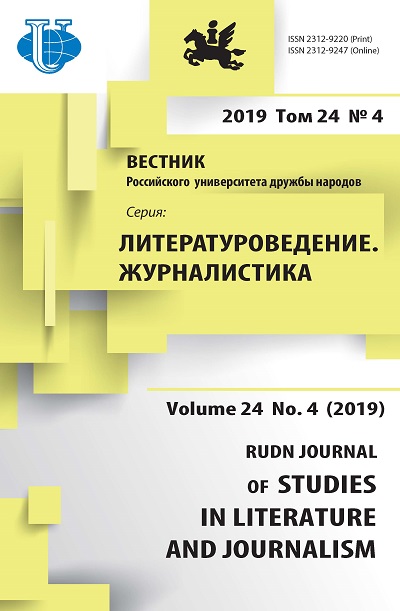The narrative structure in the N. Abgaryan trilogy “Manyunya”
- Authors: Kikhney L.G.1, Osipova O.I.2
-
Affiliations:
- Institute of International Law and Economy of A.S. Griboedov
- Far Eastern State Technical Fisheries University
- Issue: Vol 24, No 4 (2019)
- Pages: 607-615
- Section: LITERARY CRITICISM
- URL: https://journals.rudn.ru/literary-criticism/article/view/23061
- DOI: https://doi.org/10.22363/2312-9220-2019-24-4-607-615
- ID: 23061
Cite item
Full Text
Abstract
The narrative structure of a modern autobiographical novel is being studied in the article based on the N. Abgaryan trilogy “Manyunya”. It is noted that in general the above autobiographical genre retains constant features. The latter include the techniques of creation of the chronotype, creation the embodiment of the image of the character, the prototype of whom is the author of the novel. But the transformation of genre is quite evident in the structure of the narration changes, which includes the implicit dialogue with reader. It is shown that the novel is characterized by the narrative experiments: the narrator maybe both inside and outside the world of character. The specifi c nature of narration is also characterized by the ironic modus in the novel trilogy. It is proved that the irony of the author does not aim at mocking the described events. It refers to a language game that engages readers into this game with the meanings contexts set by the author. The mentioned style of narrative plays an important role in readership and makes the autobiographical narrative innovation.
Keywords
About the authors
Lyubov G. Kikhney
Institute of International Law and Economy of A.S. Griboedov
Author for correspondence.
Email: lgkihney@yandex.ru
Doctor of Philology, Professor, Head of Department of Journalism History and Literature
21 Shosse Entuziastov, Moscow, 111024, Russian FederationOlga I. Osipova
Far Eastern State Technical Fisheries University
Email: fia-fa@mail.ru
Doctor of Philological Sciences, Head of the Department of Russian as a Foreign Language
52B Lugovaya St., Vladivostok, 690087, Russian FederationReferences
- Abgaryan N.Yu. Vsyo o Manyune. Moscow: AST Publ., 2017. 862 p.
- Van Czyao. Sovremennaya russkaya avtobiografi cheskaya proza vo vremennyh otnosheniyah [Modern Russian autobiographical prose in temporary relations] // RUDN Journal of Studies in Literature and Journalism. 2017. No. 3. Pp. 466–474.
- Zinchenko N.S. Ironiya kak mnogoaspektnyj fenomen: metodologicheskie osnovy hudozhestvennogo diskursa [Irony as a multidimensional phenomenon: methodological foundations of artistic discourse] // Filologicheske nauki. Voprosy teorii i praktiki [Philological Sciences. Issues of Theory and Practice]. 2016. No. 3–1. Pp. 126–130.
- Kosova Yu.A. Ironicheskoe pis’mo v sozdanii novoj versii avtobiografi zma v trilogii Zh. Ruo “Polya chesti”, “Znamenitye lyudi”, “Mir ne v fokuse” // RUDN Journal of Studies in Literature and Journalism. 2014. No. 2. Pp. 52–58.
- Limareva T.F. Funkcional’no-semanticheskaya sushchnost’ ironii [Functional-semantic essence of irony]: avtoref. dis. … kand. fi lol. nauk. Krasnodar, 1997. 19 p.
- Nyubina L.M. Kategoriya vremeni v tekstah literaturnoj avtobiografi i [Time category in literary autobiography texts] // Grammatika v nauchno-issledovatel’skom kontekste sovremennoj lingvistiki: materialy nauchnyh chtenij pamyati prof. L.V. Shishkovoj [Grammar in the research context of modern linguistics: materials of scientifi c readings of memory prof. L.V. Shishkova]. 2017. Pp. 104–116.
- Shilihina K.M. Ironicheskij narrativ: osobennosti struktury teksta [Ironic Narrative: Peculiarities of Text Structure] // Vestnik VGU. Seriya: Lingvistika i mezhkul’turnaya kommunikaciya [VSU Gazette. Series: Linguistics and Intercultural Communication]. 2013. No. 1. Pp. 59–63.
Supplementary files















